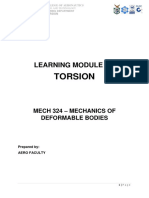Chapter 4. Finite Element Modeling and Solution Techniques
Uploaded by
Shanmukha SundaramChapter 4. Finite Element Modeling and Solution Techniques
Uploaded by
Shanmukha SundaramLecture Notes: Introduction to Finite Element Method
Chapter 4. FE Modeling and Solution Techniques
Chapter 4. Finite Element Modeling and Solution Techniques
I. Symmetry
A structure possesses symmetry if its components are arranged in a periodic or reflective manner.
Types of Symmetry: Reflective (mirror, bilateral) symmetry Rotational (cyclic) symmetry Axisymmetry Translational symmetry ...
Examples:
1998 Yijun Liu, University of Cincinnati
105
Lecture Notes: Introduction to Finite Element Method
Chapter 4. FE Modeling and Solution Techniques
Applications of the symmetry properties: Reducing the size of the problems (save CPU time, disk space, postprocessing effort, etc.) Simplifying the modeling task Checking the FEA results ...
Symmetry of a structure should be fully exploited and retained in the FE model to ensure the efficiency and quality of FE solutions.
Examples:
Cautions: In vibration and buckling analyses, symmetry concepts, in general, should not be used in FE solutions (works fine in modeling), since symmetric structures often have antisymmetric vibration or buckling modes.
1998 Yijun Liu, University of Cincinnati
106
You might also like
- Michael Okereke, Simeon Keates - Finite Element Applications. A Practical Guide To The FEM Process-Springer (2018) PDFNo ratings yetMichael Okereke, Simeon Keates - Finite Element Applications. A Practical Guide To The FEM Process-Springer (2018) PDF482 pages
- Theoretical and Experimental Modal Analysis0% (1)Theoretical and Experimental Modal Analysis25 pages
- Optimization For Engineers by Kalyanmoy Deb69% (16)Optimization For Engineers by Kalyanmoy Deb45 pages
- Chapter 7 - Practical Considerations in Modeling: Learning ObjectivesNo ratings yetChapter 7 - Practical Considerations in Modeling: Learning Objectives44 pages
- Process Systems Engineering Chapter 4 Optimization of Process SystemsNo ratings yetProcess Systems Engineering Chapter 4 Optimization of Process Systems86 pages
- Basic Linear Static Finite Element AnalysisNo ratings yetBasic Linear Static Finite Element Analysis19 pages
- (Wk1a) 1.0 Introduction To Process Dynamics - 606No ratings yet(Wk1a) 1.0 Introduction To Process Dynamics - 60613 pages
- N Khumalo (230014724) Tutorial 1 and 2 SolutionsNo ratings yetN Khumalo (230014724) Tutorial 1 and 2 Solutions10 pages
- Finite Element Methods of Structural Analysis100% (1)Finite Element Methods of Structural Analysis98 pages
- HELM Workbook 5 Functions and ModellingNo ratings yetHELM Workbook 5 Functions and Modelling49 pages
- Ansys CFD Analysis Professional Course (Epsilon-e)No ratings yetAnsys CFD Analysis Professional Course (Epsilon-e)8 pages
- 1.1. Designing Applications Course OverviewNo ratings yet1.1. Designing Applications Course Overview6 pages
- Cutting Forces Evaluation in Milling Using An Anal PDFNo ratings yetCutting Forces Evaluation in Milling Using An Anal PDF10 pages
- 2015 Book EngineeringComputationOfStruct PDF100% (1)2015 Book EngineeringComputationOfStruct PDF325 pages
- Multiple Models Approach in Automation: Takagi-Sugeno Fuzzy SystemsFrom EverandMultiple Models Approach in Automation: Takagi-Sugeno Fuzzy SystemsNo ratings yet
- Chapter 6. Solid Elements For 3-D Problems I. 3-D Elasticity TheoryNo ratings yetChapter 6. Solid Elements For 3-D Problems I. 3-D Elasticity Theory6 pages
- Introduction To Finite Element Method - Chapt - 02 - Lect04No ratings yetIntroduction To Finite Element Method - Chapt - 02 - Lect049 pages
- IV. Nature of Finite Element Solutions: Stiffening EffectNo ratings yetIV. Nature of Finite Element Solutions: Stiffening Effect7 pages




































































